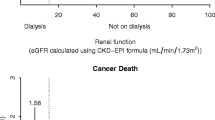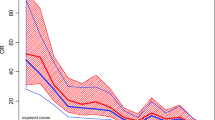Abstract
The risk for kidney cancer was examined in a Danish cohort of 192,133 people on a hospital discharge register who had been given a diagnosis of hypertension, heart failure, or edema, and were presumed to be probable users of diuretics. The subjects were identified from 1977 to 1987 and followed-up for cancer through 1987. A total of 10,630 cancers was observed. While the risk for all cancers was increased slightly (standard mortality ratio [SMR]=122, 95 percent confidence interval [CI]=120–124), the risk for renal cell carcinoma was more than doubled (SMRmen=221, CI=192–253; SMRwomen=246, CI=213–283). Increased risks were found in all age groups, and, although surveillance bias was present initially, the risk increased consistently in the years following discharge. Risk estimates for individuals discharged with hypertension were similar to those for the total cohort. Use of diuretics was validated in a random sample of 100 individuals. More than 70 percent were taking diuretics at the time of discharge. The increased risk for renal cell carcinoma in this cohort may indicate either that diuretics are involved in the etiology of renal cell carcinoma or that the risk can be attributed to confounders, including smoking, which affect risk for both the discharge diagnosis and renal cell carcinoma.
Similar content being viewed by others
References
Jensen, OM, Knudsen, JB, McLaughlin, JK, et al. The Copenhagen case-referent study of renal pelvis and ureter cancer: the role of smoking and occupational exposures. Int J Cancer 1988; 41: 557–61.
IARC Working Group. Phenacetin and mixtures containing phenacetin. Lyon, France: International Agency for Research on Cancer, 1987; IARC Monographs suppl. 7: 310–2.
Armstrong, B, Garrod, A, Doll, R. A retrospective study of renal cancer with special reference to coffee and animal protein consumption. Br J Cancer 1976; 33: 127–36.
Yu, MC, Mack, TM, Hanish, R, et al. Cigarette smoking, obesity, diuretic use, and coffee consumption as risk factors for renal cell carcinoma. JNCI 1986; 77: 351–6.
McLaughlin, JK, Mandel, JS, Blot, WJ, et al. Population based case-control study of renal cell carcinoma. JNCI 1984; 72: 275–84.
McLaughlin, JK, Blot, WJ, Fraumeni, JF. Diuretics and renal cell carcinoma. JNCI 1988; 80: 378.
McCredie, M, Ford, JM, Stewart, JH. Risk factors for cancer of the renal parenchyma. Int J Cancer 1988; 42: 13–6.
Asal, NR, Risser, DR, Kadami, S, et al. Risk factors in renal cell carcinoma. I. Methodology, demographics, tobacco, beverage use, and obesity. Cancer Det Prev 1988; 11: 359–77.
Grove, JS, Nomura, A, Severson, RK, Stemmermann, GN. The association of blood pressure with cancer incidence in a prospective study. Am J Epidemiol 1991; 134: 942–7.
World Health Organization. International Classification of Diseases, Injuries and Causes of Death. Eighth Revision (1968). Geneva: WHO, 1969.
Storm, HH, Manders, T, Sprøgel, P, et al. Cancer Indicidence in Denmark 1987. Copenhagen: Danish Cancer Society, 1990.
Kirchner, FK, Braren, V, Smith, C, et al. Renal carcinoma discovered incidentally by arteriography during evaluation for hypertension, J Urol 1976; 115: 643–5.
Sufrin, G, Murphy, GP. Renal adenocarcinoma. Urol Surveys 1980; 30: 129–44.
Appleyard M (ed.). The Copenhagen City Heart Study. Scan J Soc Med 1989; Suppl. 41: 113.
Fraser, GE, Phillips, RL, Beeson, WL. Hypertension, antihypertensive medication and risk of renal carcinoma in California Seventh-day Adventists. Int J Epidemiol 1990: 19; 832–8.
Selby, JV, Friedman, GD, Fireman, BH. Screening prescription drugs for possible carcinogenicity: 11–15 years of follow-up. Cancer Res 1989; 49: 5736–47.
Lijinsky, W, Reuber, MD. Pathological effects of chronic administration of chlorothiazide, with and without sodium nitrite, to F344 rats. Toxicol Ind Health 1987; 3: 413–22.
National Toxicology Program. Toxicology and Carcinogenesis Studies of Hydroclorothiazide in F344/N Rats and B6C3F Mice. NTP Technical Report No. 357. Research Triangle Park, North Carolina, 1989.
National Toxicology Program. Toxicology and carcinogenesis studies of furosemide in F344/N rates and B6C3F mice. NTP Technical Report No. 356. Research Triangle Park, North Carolina, 1989.
Additional information
Authors are with the Danish Cancer Registry, Danish Cancer Society, Rosenvængets Hovedvej 38, Box 839 Copenhagen DK-2100ø, Denmark. Address correspondence to Dr Mellemgaard.
Rights and permissions
About this article
Cite this article
Mellemgaard, A., Møller, H. & Olsen, J.H. Diuretics may increase risk of renal cell carcinoma. Cancer Causes Control 3, 309–312 (1992). https://doi.org/10.1007/BF00146883
Received:
Accepted:
Issue Date:
DOI: https://doi.org/10.1007/BF00146883




